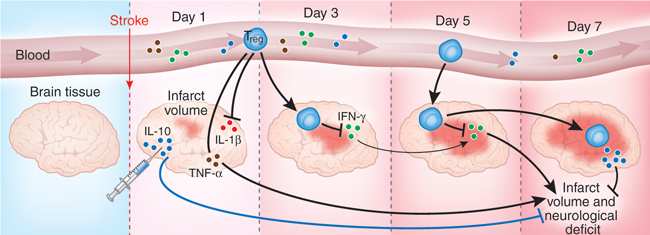博文
保护大脑的新策略
 精选
精选
|||
利用免疫调节来保护大脑
阅读脾切除和最近德国关于免疫细胞保护大脑研究论文的感想.
去年看到过关于切除脾脏来保护大脑损伤的研究,感觉很有意思。
研究的思路是这样的,来自韩国的一个小组发现外周注射神经干细胞能保护脑出血后神经系统损伤。很自然,要能在脑内寻找这些外来的神经干细胞,结果很意外,发现脑内神经干细胞很少,不能解释其保护效应,但更奇怪的是,他们发现这些干细胞大部分达到脾脏。这个问题就来了,神经干细胞到脾脏能保护大脑吗?于是他们就把脾脏切除,结果发现,单纯切除脾脏就能保护大脑。
我回头找了一些文献,发现切除脾对保护中枢以外的器官已经有一些研究,例如保护肺损伤,其思路是这些器官损伤与炎症有关,而脾脏是促进炎症反应的,那么切脾脏保护这些炎症损伤的器官就理所当然了。
继续看,结果发现有人利用CdCL3来封闭巨噬细胞也能代替脾脏切除发挥对这些器官的保护作用,就是说巨噬细胞是其中比较重要的炎症细胞。
按理说,这些思路有意思,但也没什么大不了的。
最近德国学者在自然医学报道的另一个文章又让我对上述研究有些回忆,见"特殊细胞可在中风后保护大脑",英文全文,并感觉对自己非常失望。
德国学者的研究是,发现来自胸腺的Treg细胞是神经保护细胞。这个研究的本质是,这类细胞是抑制免疫或者炎症反应的重要细胞,能在中枢系统损伤的时候进入大脑,通过抑制免疫反应达到保护神经系统的作用。
这个工作应该与脾脏切除的研究属于一个整体,就是说:炎症反应在中枢神经系统损伤中非常重要,而炎症反应肯定要受到免疫系统的调节,调节炎症肯定存在两个不同的内容,一种是促进炎症发生的细胞或系统,另一种是抑制炎症反应的细胞或者系统。那么通过对这两种不同方向的免疫反应进行调节,就可以实现控制炎症,保护损伤的目的。这样的一个分析应该早就能想到,可惜我没有。现在感觉很遗憾。不过我想,将来可以用同样的思路对其他各类损伤开展深入研究。随着对Treg细胞的认识,例如找到如何调节的方法或药物,就可以用来治疗这些炎症了。另外对中枢神经系统来讲,因为血脑屏障的存在,一直是药物治疗的一个很大障碍,那么这些炎症调节细胞都能通过。也就是说可以作为药物的载体进行治疗神经损伤,不仅他们自己能治疗疾病,而且能带一些药物进入脑内,可以作为一种研究的思路。
Brain. 2008 Mar;131(Pt 3):616-29. Epub 2007 Dec 20. Links
Comment in:
Brain. 2008 Aug;131(Pt 8):e100; author reply e101.
Brain. 2008 Mar;131(Pt 3):604-5.
Anti-inflammatory mechanism of intravascular neural stem cell transplantation in haemorrhagic stroke.Lee ST,
Stroke & Stem Cell Laboratory, Clinical Research Institute, Stem Cell Research Center, Department of Neurology, Seoul National University Hospital, Seoul, South Korea.
Neural stem cell (NSC) transplantation has been investigated as a means to reconstitute the damaged brain after stroke. In this study, however, we investigated the effect on acute cerebral and peripheral inflammation after intracerebral haemorrhage (ICH). NSCs (H1 clone) from fetal human brain were injected intravenously (NSCs-iv, 5 million cells) or intracerebrally (NSCs-ic, 1 million cells) at 2 or 24 h after collagenase-induced ICH in a rat model. Only NSCs-iv-2 h resulted in fewer initial neurologic deteriorations and reduced brain oedema formation, inflammatory infiltrations (OX-42, myeloperoxidase) and apoptosis (activated caspase-3, TUNEL) compared to the vehicle-injected control animals. Rat neurosphere-iv-2 h, but not human fibroblast-iv-2 h, also reduced the brain oedema and the initial neurologic deficits. Human NSCs-iv-2 h also attenuated both cerebral and splenic activations of tumour necrosis factor-alpha (TNF-alpha), interleukin-6 (IL-6), and nuclear factor-kappa B (NF-kappa
这个研究发现外周注射干细胞是通过与脾脏相互作用,通过抑制全身免疫反应,发挥治疗脑出血损伤的.不知道是否在其他器官损伤也存在类似的情况吗?例如肾脏和肝脏.这值得深入研究和思考.: J Neurosci Res. 2008 Aug 1;86(10):2227-34. Links
The spleen contributes to stroke-induced neurodegeneration.Ajmo CT Jr, Vernon DO, Collier L, Hall AA, Garbuzova-Davis S, Willing A, Pennypacker KR.
Department of Molecular Pharmacology and Physiology, University of South Florida, Tampa, Florida 33216, USA.
Stroke, a cerebrovascular injury, is the leading cause of disability and third leading cause of death in the world. Recent reports indicate that inhibiting the inflammatory response to stroke enhances neurosurvival and limits expansion of the infarction. The immune response that is initiated in the spleen has been linked to the systemic inflammatory response to stroke, contributing to neurodegeneration. Here we show that removal of the spleen significantly reduces neurodegeneration after ischemic insult. Rats splenectomized 2 weeks before permanent middle cerebral artery occlusion had a >80% decrease in infarction volume in the brain compared with those rats that were subjected to the stroke surgery alone. Splenectomy also resulted in decreased numbers of activated microglia, macrophages, and neutrophils present in the brain tissue. Our results demonstrate that the peripheral immune response as mediated by the spleen is a major contributor to the inflammation that enhances neurodegeneration after stroke.

Treg cells prevent delayed lesion expansion in an IL-10–dependent manner. They also temper the proinflammatory cytokine burst starting early time points after ischemia. Injection of IL-10 in the brain reduces infarct volume. TNF- , tumor necrosis factor-
, tumor necrosis factor- ; IFN-
; IFN- , interferon-
, interferon- .
.
Katie Vicari
文章附件资料https://wap.sciencenet.cn/blog-41174-222232.html
上一篇:科学网的山东老乡
下一篇:我发表的论文全文汇编